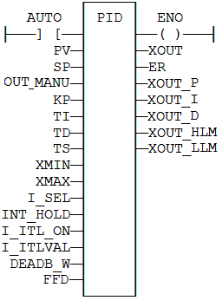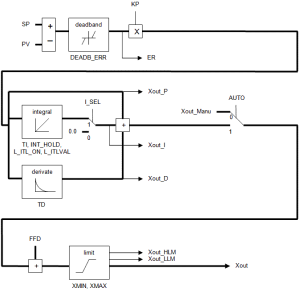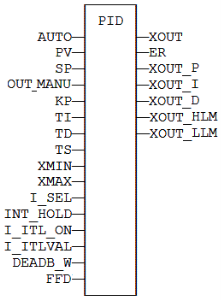![]()
 Function Block
Function Block![]() A function block groups an algorithm and a set of private data. It has inputs and outputs. - PID
A function block groups an algorithm and a set of private data. It has inputs and outputs. - PID![]() "Proportional-Integral-Derivative"
A PID controller is a generic control-loop feedback mechanism widely used in industrial control systems.
An "error" occurs when an event or a disturbance triggers off a change in the process variable.
A PID controller attempts to correct the error between a measured process variable and a desired setpoint by calculating and then outputting a corrective action that can adjust the process accordingly loop
"Proportional-Integral-Derivative"
A PID controller is a generic control-loop feedback mechanism widely used in industrial control systems.
An "error" occurs when an event or a disturbance triggers off a change in the process variable.
A PID controller attempts to correct the error between a measured process variable and a desired setpoint by calculating and then outputting a corrective action that can adjust the process accordingly loop
See Regulation for more information.
Inputs
|
Input |
Data Type |
Range |
Unit |
Default |
Description |
|---|---|---|---|---|---|
|
AUTO |
BOOL |
|
|
|
|
|
DEADB_ERR |
REAL |
|
|
|
Hysteresis on PV. PV is considered as unchanged if it is both:
|
|
FFD |
REAL |
|
|
|
Disturbance value on output. |
|
I_ITL_ON |
BOOL |
|
|
|
If TRUE, the integrated value is reset to I_ITLVAL. |
|
I_ITLVAL |
REAL |
|
|
|
Reset value for integration when I_ITL_ON is TRUE. |
|
I_SEL |
BOOL |
If FALSE, the integrated value is ignored. |
|||
|
INT_HOLD |
BOOL |
If TRUE, the integrated value is frozen. |
|||
|
KP |
REAL |
Gain. |
|||
|
PV |
REAL |
Process value. |
|||
|
SP |
REAL |
Set point. |
|||
|
TD |
REAL |
Derivation factor. |
|||
|
TI |
REAL |
Integration factor. |
|||
|
TS |
TIME |
Sampling period. |
|||
|
XMAX |
REAL |
Maximum output value. |
|||
|
XMIN |
REAL |
Minimum allowed output value. |
|||
|
Xout_Manu |
REAL |
Output value in manual mode. |
Outputs
|
Output |
Data Type |
Range |
Unit |
Description |
|---|---|---|---|---|
|
ER |
REAL |
|
|
Last calculated error. |
|
Xout |
REAL |
|
|
Output command value. |
|
Xout_D |
REAL |
|
|
Last calculated derivated value. |
|
Xout_HLM |
BOOL |
|
|
TRUE if the output value is saturated to XMAX. |
|
Xout_I |
REAL |
|
|
Last calculated integrated value. |
|
Xout_LLM |
BOOL |
|
|
TRUE if the output value is saturated to XMIN. |
|
Xout_P |
REAL |
|
|
Last calculated proportional value. |
Remarks
- It is important for the stability of the control that the TS sampling period is much bigger than the cycle time.
- Output of the PID block always starts with zero.
- The value varies per the inputs provided upon further cycle executions.
- In the FFLD Language, the output rung has the same value as the AUTO input, corresponding to the input rung.
Diagram
FBD Language
FFLD Language
(* ENO has the same state as the input rung. *)

IL Language
(* MyPID is a declared instance of PID function block. *)
Op1: CAL MyPID (AUTO, PV, SP, XOUT_MANU, KP, TI, TD, TS, XMIN, XMAX, I_SEL, I_ITL_ON, I_ITLVAL, DEADB_ERR, FFD)
FFLD MyPID.XOUT
ST"Structured text" A high-level language that is block structured and syntactically resembles Pascal XOUT
FFLD MyPID.ER
ST ER
FFLD MyPID.XOUT_P
ST XOUT_P
FFLD MyPID.XOUT_I
ST XOUT_I
FFLD MyPID.XOUT_D
ST XOUT_D
FFLD MyPID.XOUT_HLM
ST XOUT_HLM
FFLD MyPID.XOUT_LLM
ST XOUT_LLM
ST Language
(* MyPID is a declared instance of PID function block. *)
MyPID (AUTO, PV, SP, XOUT_MANU, KP, TI, TD, TS, XMIN, XMAX, I_SEL, I_ITL_ON, I_ITLVAL, DEADB_ERR, FFD);
XOUT := MyPID.XOUT;
ER := MyPID.ER;
XOUT_P := MyPID.XOUT_P;
XOUT_I := MyPID.XOUT_I;
XOUT_D := MyPID.XOUT_D;
XOUT_HLM := MyPID.XOUT_HLM;
XOUT_LLM := MyPID.XOUT_LLM;








